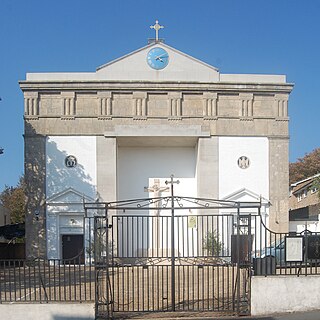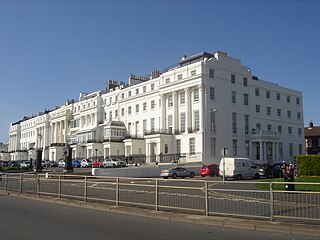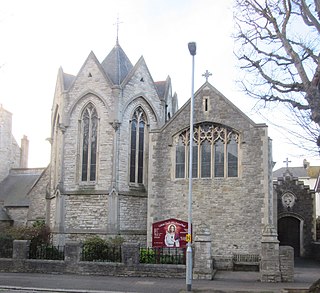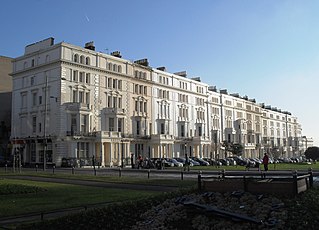History
The area between Brighton, to the east, and the ancient centre of Hove, to the west, was farmland until the 1820s, when Brunswick Town was developed in response to the success of the Kemp Town estate in Brighton—a planned estate of high-class houses, servants' quarters and other buildings, all in the Regency style. Architect Charles Busby planned and built the Brunswick Town estate, which (together with other nearby residential development) helped the population of Hove to rise from 100 in 1801 to 2,500 in 1841. [3]
The only church nearby was St Andrew's, the ancient parish church; this was some distance away and had fallen into near-dereliction. The curate of the (now demolished) St Margaret's Church in Cannon Place, Brighton, Rev. Edward Everard, owned some land near the former Wick Farm, on which the Brunswick Town estate had been built. He was aware that there was no plan to build a church in the estate, so he decided to build a proprietary chapel on his land. [4] [5] Rev. Everard knew Charles Busby, but they had fallen out after a disagreement in 1824 over the commission for the Sussex County Hospital (now the Royal Sussex County Hospital) in Brighton: Everard was overruled by other members of the planning committee and had to break his promise that Busby would be allowed to design it. Therefore, Everard looked for a different architect to design and build the church, and Charles Barry—who had already built the hospital and St Peter's Church in Brighton—was chosen. [5] The church has a blue plaque commemorating Barry. [6]
Construction started in April 1827. Everard was granted an Act of Parliament on 3 April 1828 giving him and his successors ownership of the church, the right to appoint a curate for the next 40 years, and two-thirds of income from pew rents and other sources. Everard himself acted as the first curate, from the church's consecration on 5 July 1828 until 1838, one year before his death. [7]
St Andrew's immediately became popular with the fashionable set, helped by the regular presence of members of the Royal Family and the aristocracy. Among the many Dukes and Duchesses to worship there in the mid-19th century was the elderly Prince Adolphus, Duke of Cambridge, who often made loud and sometimes eccentric comments and remarks during services. [8] Between 300 and 350 people regularly worshipped at the church in 1851 according to a census taken during that year; there were 420 pews, 340 of which were subject to pew rents. [8]
The interior was reordered in 1869, with new open benches installed in place of individual seats. [8] A more radical change took place in 1882, [2] when the church was extended at a cost of £7,000 (£2,000 to buy and demolish an adjacent stable block and £5,000 for the construction work); [3] [9] Charles Barry's son Edward Middleton Barry added a chancel, a sanctuary with Ionic columns, an illuminated dome and space for an organ. Although the organ is no longer in place, its case has been retained. [9] A pulpit had been donated in 1918, [2] and more additions were made in the 1920s, including enlargements to the altar case, a pedimented baldacchino above the altar, a marble font with its own baldacchino, new stained glass windows and new, clearer Venetian glass surrounding these. The changes cost £4,000. [2] [3] The stated intention was to brighten the interior of the church and "create a little piece of Italy" within the Italianate building. [8]
The church remained in use until the late 20th century, but was declared redundant on 14 February 1990 because of declining attendance at services. [1] [3] The decline had set in several decades earlier, and the Diocese were considering demolition; the granting of Grade I-listed status on 24 March 1950 meant this could not happen. [8] The Churches Conservation Trust now owns and maintains the building. [8] Squatters caused damage during the 1990s, [10] but restoration work in 2001 and 2002, costing more than £100,000, allowed the building to be reopened for occasional services, special events and community activities. [10]
The church was always unparished, having been built as a chapel of ease to St Andrew's in Church Road. [11]
Starting September 22, 2013 the Church has been used monthly as the venue for the Brighton and Hove Chapter of The Sunday Assembly. [12]
Architecture
The exterior, facing west, is the first example in England of the Italianate style being used on a church. [2] [5] [7] Originally, the interior was less grand, with no chancel, simple pulpits and a single gallery, [7] making it a plain, box-like preaching-house. [8] The building materials used for the exterior are brick and ashlar. The entrance door is set beneath a round-headed arched opening between twin pilasters, the outer pair of which serve as quoins for the adjacent recessed walls. [2] There is a small domed bell tower with a lead roof and clock faces, [2] containing a bell cast in 1930 as a replacement for an early 19th-century predecessor (this bore an inscription dated 1811). [13]
In its present form, the interior consists of a gallery at the west end, nave, transepts on two sides, a chancel, a side chapel in the southeast corner and a vestry in the northeast, with Italianate top-lighting and domes. The narthex, from where a stone staircase leads up to the gallery, is also top-lit, and now contains most of the church's memorial stones; [2] these were moved there from the body of the church after it was declared redundant. Five, including memorials commemorating Lord Charles Somerset and Sir George Dallas, 1st Baronet, remain in the nave, however. [10]
St Andrew's is the only church in Hove to have burial vaults beneath it. Space for burials was restricted in the Brunswick Town area by the time the church was built, because of the rapid residential development, and the churchyard at St Andrew's on Church Road was difficult to get to. Lord Charles Somerset, an M.P. who later became Governor of the Cape Colony in South Africa, was the first person to be buried in the vault, in 1831. [14] A court order in 1854 prevented any more burials being made, and the vaults were used as air-raid shelters during World War II. [13]

Hove is a seaside resort in East Sussex, England. Alongside Brighton, it is one of the two main parts of the city of Brighton and Hove.

St. Michael's Church is an Anglican church in Brighton, England, dating from the mid-Victorian era. Located on Victoria Road in the Montpelier area, to the east of Montpelier Road, it is one of the largest churches in the city of Brighton and Hove. The church is a Grade I listed building.

All Saints Hove is an Anglican church in Hove, part of the English city of Brighton and Hove. It has served as the parish church for the whole of Hove since 1892, and stands in a prominent location at a major crossroads in central Hove.

St George's Church is an Anglican church in the Kemptown area of Brighton, in the English city of Brighton and Hove. It was built at the request of Thomas Read Kemp, who had created and financed the Kemp Town estate on the cliffs east of Brighton in the early 19th century, and is now regarded as the parish church of the wider Kemptown area. It is a Grade II listed building.

St Andrew's Church is an Anglican church in Church Road, Hove, in the English city of Brighton and Hove. It is usually referred to as St Andrew (Old Church) to distinguish it from another St Andrew's Church in Waterloo Street, elsewhere in Hove. It served as Hove's parish church for several centuries until 1892, although the building was in a state of near-ruin until Hove began to grow from an isolated village to a popular residential area in the early 19th century.

St Patrick's Church is an Anglican church in Hove, in the English city of Brighton and Hove. Situated on a narrow site at 3 Cambridge Road, off Western Road close to the boundary with Brighton, it is still in use as a place of worship. Since 1985 St Pat's developed a special ministry with homeless people, setting up a night shelter and a homeless hostel. In 2012, St Patrick's night shelter was closed. The homeless hostel continues to operate under new management, and is currently run by Riverside Housing Association. The church closed as a parish in 2015, and was then entrusted by the Bishop of Chichester to the Chemin Neuf Community under a Bishop's Mission Order. The leader of the Chemin Neuf Mission at St Patrick's is currently the Revd Tim Watson.

St Nicolas Church is an Anglican church in the Portslade area of the English city of Brighton and Hove. It has 12th-century origins, and serves the old village of Portslade, inland from the mostly 19th-century Portslade-by-Sea area.

The Church of the Holy Trinity is a Greek Orthodox church in Brighton, part of the English city of Brighton and Hove. Built in 1838 in one of Brighton's most notorious slum districts, Carlton Hill, it was an Anglican church for most of its life: dedicated to St John the Evangelist, it was used by the Anglican community until it was declared redundant in 1980. After some uncertainty about its future, it was sold to Brighton's Greek Orthodox community in 1985 and has been used as their permanent place of worship since then. Reflecting its architectural and historical importance, it has been listed at Grade II since 1971.

Holy Trinity Church is a former Anglican church in Hove, in the English city of Brighton and Hove. Built in the early 1860s to provide extra capacity for Anglican worshippers in the rapidly growing town of Hove, its use declined in the 20th century and it was closed in 2007 following a Diocesan review. Until 2015—when a planning application to convert the building into a doctors surgery was approved—its future was uncertain, and a heritage group has described it as one of Britain's top ten threatened Victorian and Edwardian buildings. The church, which has been a medical centre since 2017, has Grade II listed status, reflecting its architectural and historic importance.

There are 24 Grade I listed buildings in the city of Brighton and Hove, England. The city, on the English Channel coast approximately 52 miles (84 km) south of London, was formed as a unitary authority in 1997 by the merger of the neighbouring towns of Brighton and Hove. Queen Elizabeth II granted city status in 2000.

St Peter's Church is a Roman Catholic church in the Aldrington area of Hove, part of the English city of Brighton and Hove. It is one of three Roman Catholic churches in Hove and one of eleven in the wider city area. Built between 1912 and 1915 in a red-brick Romanesque style, its tall campanile forms a local landmark. It has been listed at Grade II by English Heritage in view of its architectural importance.

Holland Road Baptist Church is a Baptist church in Hove, part of the English city of Brighton and Hove. Built in 1887 to replace a temporary building on the same site, which had in turn superseded the congregation's previous meeting place in a nearby gymnasium, it expanded to take in nearby buildings and is a landmark on Holland Road, a main north–south route in Hove. It is one of ten extant Baptist church buildings in the city, and is the only one to have been listed by English Heritage in view of its architectural importance.

Amon Wilds was an English architect and builder. He formed an architectural partnership with his son Amon Henry Wilds in 1806 and started working in the fashionable and growing seaside resort of Brighton, on the East Sussex coast, in 1815. After 1822, when the father-and-son partnership met and joined up with Charles Busby, they were commissioned—separately or jointly—to design a wide range of buildings in the town, which was experiencing an unprecedented demand for residential development and other facilities. Wilds senior also carried out much work on his own, but the description "Wilds and Busby" was often used on designs, making individual attribution difficult. Wilds senior and his partners are remembered most for his work in post-Regency Brighton, where most of their houses, churches and hotels built in a bold Regency style remain—in particular, the distinctive and visionary Kemp Town and Brunswick estates on the edges of Brighton, whose constituent parts are Grade I listed buildings.

The Church of the Sacred Heart is a Roman Catholic church in Hove, part of the English city of Brighton and Hove. It is the oldest of Hove's three Roman Catholic churches, and one of eleven in the city area. It has been designated a Grade II Listed building.

The Union Chapel, also known as the Union Street Chapel, Elim Free Church, Four Square Gospel Tabernacle or Elim Tabernacle of the Four Square Gospel, is a former chapel in the centre of Brighton, a constituent part of the city of Brighton and Hove, England. After three centuries of religious use by various congregations, the chapel—which had been Brighton's first Nonconformist place of worship—passed into secular use in 1988 when it was converted into a pub. It was redesigned in 1825, at the height of Brighton's Georgian building boom, by at least one of the members of the Wilds–Busby architectural partnership, Brighton's pre-eminent designers and builders of the era, but may retain some 17th-century parts. It has been listed at Grade II in view of its architectural importance.

St Mark's Church is a former Anglican church in the Kemptown area of Brighton, part of the English city of Brighton and Hove. Originally intended as the private chapel of the adjacent St Mary's Hall school, it was partly built in 1838 at the request of Frederick Hervey, 1st Marquess of Bristol; but arguments over whether or not it should also be open to the public delayed its completion for more than 10 years. It became the parish church of Kemptown in 1873, but declining attendances resulted in a declaration of redundancy in 1986. At that time it was taken over by the school and became its chapel, nearly 150 years after this was first proposed. The Early English-style stone and concrete structure has been criticised by architectural historians, but has been listed at Grade II by English Heritage for its architectural and historical importance.

Brighton and Hove, a city on the English Channel coast in southeast England, has a large and diverse stock of buildings "unrivalled architecturally" among the country's seaside resorts. The urban area, designated a city in 2000, is made up of the formerly separate towns of Brighton and Hove, nearby villages such as Portslade, Patcham and Rottingdean, and 20th-century estates such as Moulsecoomb and Mile Oak. The conurbation was first united in 1997 as a unitary authority and has a population of about 253,000. About half of the 20,430-acre (8,270 ha) geographical area is classed as built up.

Palmeira Square is a mid-19th-century residential development in Hove, part of the English city and seaside resort of Brighton and Hove. At the southern end it adjoins Adelaide Crescent, another architectural set-piece which leads down to the seafront; large terraced houses occupy its west and east sides, separated by a public garden; and at the north end is one of Hove's main road junctions. This is also called Palmeira Square, and its north side is lined with late 19th-century terraced mansions. Commercial buildings and a church also stand on the main road, which is served by many buses.

Adelaide Crescent is a mid-19th-century residential development in Hove, part of the English city and seaside resort of Brighton and Hove. Conceived as an ambitious attempt to rival the large, high-class Kemp Town estate east of Brighton, the crescent was not built to its original plan because time and money were insufficient. Nevertheless, together with its northerly neighbour Palmeira Square, it forms one of Hove's most important architectural set-pieces. Building work started in 1830 to the design of Decimus Burton. The adjacent land was originally occupied by "the world's largest conservatory", the Anthaeum; its collapse stopped construction of the crescent, which did not resume until the 1850s. The original design was modified and the crescent was eventually finished in the mid-1860s. Together with the Kemp Town and Brunswick Town estates, the crescent is one of the foremost pre-Victorian residential developments in the Brighton area: it has been claimed that "outside Bath, [they] have no superior in England". The buildings in the main part of Adelaide Crescent are Grade II* listed. Some of the associated buildings at the sea-facing south end are listed at the lower Grade II.





























